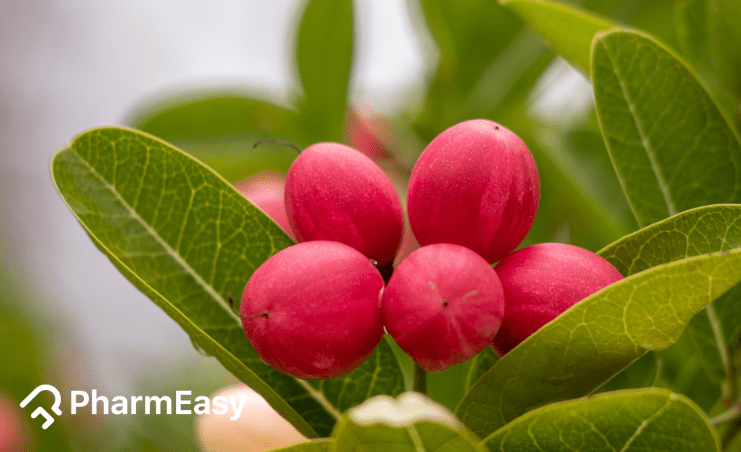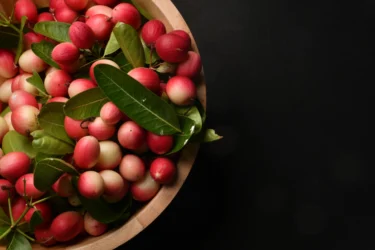Karonda (Black Currant): Uses, Benefits, Side Effects, and More By Dr. Rajeev Singh
By Dr Rajeev Singh +2 more

Get,

to manage your symptom
Get your,


4 Cr+ families
benefitted

OTP sent to 9988776655



You’ve successfully subscribed to receive
doctor-approved tips on
Whatsapp

Get ready to feel your best.

Hi There,
Download the PharmEasy App now!!


Register to Avail the Offer
Send OTPBy continuing, you agree with our Privacy Policy and Terms and Conditions

Hi There,
Sign up on PharmEasy now!!
Trusted by 4 crore+ families

OTP sent to 9988776655



You have unlocked 25% off on medicines




Code: NU25
By Dr Rajeev Singh +2 more
Table of Contents
Karonda, or Christ’s thorn, is an exotic, minor fruit plant that grows wild in bushes. Karonda is scientifically known as Carissa carandas and belongs to the family Apocynaceae. Karonda is an indigenous shrub of India. It is widely spread in the sub-tropics and tropics climate of the Himalayas, Maharashtra, Madhya Pradesh, Rajasthan, Uttar Pradesh, Bihar, and West Bengal. The karonda plant is famous for its whitish-pink berry-sized fruits. These karonda fruits are small, succulent, fleshy, and rounded with a juicy pulp. It is bitter-sour and acidic in taste and is popularly used in Indian cuisine. Karonda in English is called Bengal currants, Black currants, and Carandas-plum. Karonda in Hindi is Karaunda, Karvand in Marathi, and Koromcha in Bengali. Read along to learn more about the health benefits of karonda, its bioactive components, properties, uses, and more.

The nutritional value of Karonda per 100 g:
Karonda may contain essential compounds such as reducing sugar, flavonoids, saponins, protein, amino acids, cardinolides, terpenoids, steroids, phenolic compounds, and fatty acids. It may also contain vitamins such as A, riboflavin, thiamine, biotin, folic acid, and pantothenic acid1,3.
Karonda may have the following properties:
Karonda has been used in native systems of Indian medicine like Ayurveda, Homeopathy, and Unani due to its numerous medicinal properties3. The following may entitle a few potential uses of Karanda:

A review4 by Hameed et al. in 2021 suggests that karonda fruit extract may possess significant anti-cancer activity against lung and ovarian cancer. Karonda may contain antioxidants, flavonoids, and phenolic compounds that may exhibit free radical scavenging activity. A laboratory study1,3 on cancer cells found that daily intake of fruits in the diet may be related to reduced cancer risks. However, further human research is required to develop a true scope of karonda fruit uses for cancer. Cancer is a serious health condition that requires an appropriate diagnosis and treatment. Consult a cancer specialist, and do not self-medicate.

A review2 by Singh et al. in 2021 shows that karonda fruit may contain high sources of vitamins, antioxidants, and proteins. Its anti-microbial and antifungal properties may be beneficial for the skin. A regular intake of karonda fruit or fruit juice may help alleviate open pores and other skin-related infections2. However, this information is insufficient; therefore, more human studies are needed to suggest the karonda benefits for skin. Therefore, consult a qualified dermatologist, and do not self-medicate.
Over the years, I have observed that karonda extract might have health beneficial effects and potential as a natural anti-skin aging ingredient. It is believed that the extract can help prevent oxidative stress, reduce inflammation, and support the remodeling of the external framework matrix of your skin. These actions are important in combating skin aging and promoting healthier skin6.
Dr. Siddharth Gupta, B.A.M.S, M.D (Ayu)

An animal study5 carried out by David et al. in 2015 found that karonda fruit extract may have potential uses for diabetes. It may have anti-diabetic activity. A regular karonda intake may significantly lower the increased blood glucose levels in animals. This blood sugar-lowering activity of karonda may be due to the presence of nutrients like flavonoids and phenolic compounds1 .However, this information is insufficient as this study was conducted on animals. More human studies are needed to find the karonda benefits for diabetes. If you have diabetes consult a doctor and have karonda only if recommended.

Scurvy is a disease caused due to a deficiency in vitamin C. A literature review2 by Singh et al. done in 2021 suggests that karonda may have an abundance of vitamin C. Karonda may be acidic in nature. Its astringent and antiscorbutic (reduce scurvy) properties may provide beneficial effects such as it may restore vitamin C in the body and help recover from scurvy2. However, more human studies are needed to investigate the benefits of karonda for scurvy. If you have vitamin C deficiency, consult a qualified physician and do not self-medicate.

Though studies show the potential uses of karonda in various health conditions, these are insufficient, and there is a need for further studies to develop the scope of the benefits of karonda on human health.
In my experience, I have observed that the ethanol extract of karonda might have an antidiarrhoeal effect. In studies, it was found that the plant extracts decreased the movement of food through the gastrointestinal tract, similar to the standard drug used for this purpose. This suggests that the plant extracts could be helpful in reducing episodes of diarrhoea7.
Dr. Rajeev Singh, BAMS
Karonda fruit is commonly used in various culinary preparations2. You may use karonda in the following ways:
You should consult a qualified doctor before using karonda in large quantities. Do not discontinue or replace an ongoing modern medical treatment with an Ayurvedic/herbal preparation of karonda without consulting an Ayurvedic doctor. They will guide you with their form and dosage as per your health condition.
Over the years, I have learned that the methanolic extract of C. carandas leaves might possess hepatoprotective activity. This suggests that it has the potential to protect the liver from damage. While the exact mechanisms are not yet fully understood, it is believed that certain compounds present in the extract may contribute to its beneficial effects on liver health7.
Dr. Smita Barode, B.A.M.S, M.S.
Eating karonda in a balanced proportion is safe. No major study reports the karonda fruit side effects in humans. Therefore, it is best to avoid eating karonda in high amounts. However, if any side effects are seen after eating karonda, immediately consult a doctor and get proper treatment.
Also Read: Simhanada Guggulu: Uses, Benefits and Side Effects By Dr. Rajeev Singh
Eating karonda in excess amounts is not advised. The following precautions are necessary:
Also Read: Karisalankanni (False Daisy): Uses, Benefits, Side Effects, and More!
Furthermore, research is needed to study the interactions between karonda and other drugs. You must not presume that there are no interactions at all. Therefore, it is essential to have medical consultations with an Ayurvedic doctor. They will guide you on using karonda as a herb.
Also Read: Kachnar (Bauhinia Variegata): Uses, Benefits, Nutritional Value & More!
In Indian cooking, karonda is a famous condiment. It may be used for pickles, chutneys, cooling drinks, juice, jelly, jam, squash, syrup, tarts, puddings, wine, etc1,2.
The different names of karonda may include Bengal currants, Black currants, Carandas-plum, Christ thorn, Karaunda, Karvand, Koromcha, etc2.
Karonda vitamins may include vitamins A, C, riboflavin, thiamine, biotin, pantothenic acid and folic acid1,3.
Karonda may include properties such as cooling, anthelmintic, antioxidant, antipyretic, anti-inflammatory, antibacterial, anti-cancer, antiulcer, antiscorbutic, etc1,3.
Scurvy is a rare condition in which your body becomes deficient in vitamin C. Fresh and ripe karonda may be a rich source of vitamin C, which might help alleviate scurvy. Hence, karonda may be a good source of vitamin C for those trying to recover from scurvy2.
1. Kamal M, Jawaid T, Khalid M. Carissa carandas Linn. (Karonda): An exotic minor plant fruit with immense value in nutraceutical and pharmaceutical industries. Asian J of Biomed and Pharma Sci. 2016;6(58):14–9. Available from: https://www.researchgate.net/profile/Kuldeep-Singh-18/publication/311510769_Carissa_carandas_Linn_Karonda_An_exotic_minor_plant_fruit_with_immense_value_in_nutraceutical_and_pharmaceutical_industries/links/5849955708ae82313e710694/Carissa-carandas-Linn-Karonda-An-exotic-minor-plant-fruit-with-immense-value-in-nutraceutical-and-pharmaceutical-industries.pdf
2. Singh K, Shiv P, Singh M. Karonda: A Medicinal Plant with Immense Economic Potentials. AgriCos e-Newsletter. 2021;2(2):83–6. Available from: https://www.researchgate.net/profile/Krishan-Singh-7/publication/349237209_Karonda_A_Medicinal_Plant_with_Immense_Economic_Potentials/links/6026161c45851589399ae4c9/Karonda-A-Medicinal-Plant-with-Immense-Economic-Potentials.pdf
3. Kumar Rai G. Bioactive potential of karonda (Carissa carandas L.). Indian J Agric Biochem. 2021;34(1):24–32. Available from: https://www.researchgate.net/profile/Gyanendra-Rai-2/publication/353975087_Bioactive_potential_of_karonda_Carissa_carandas_L/links/61cec06eb6b5667157b96051/Bioactive-potential-of-karonda-Carissa-carandas-L.pdf?_sg%5B0%5D=started_experiment_milestone&origin=journalDetail
4. Virmani R, Virmani T, Singh C, Sorout G, Gupta J. Bioactive potential of Karonda (Carissa carandas L.). Res Pharm Health Sci. 2015;3(2):[page numbers]. Available from: https://www.researchgate.net/publication/353975087_Bioactive_potential_of_karonda_Carissa_carandas_L
5. David M. Spectrographic analysis and in vitro study of phytochemicals in aqueous ethanolic fruit extract. J Adv Sci Res. 2015;6(03):10-13. Available from: https://sciensage.info/index.php/JASR/article/view/235
6. Neimkhum W, Anuchapreeda S, Lin W-C, Lue S-C, Lee K-H, Chaiyana W. Effects of Carissa carandas Linn. Fruit, Pulp, Leaf, and Seed on Oxidation, Inflammation, Tyrosinase, Matrix Metalloproteinase, Elastase, and Hyaluronidase Inhibition. Antioxidants (Basel). 2021;10(9):1345. doi:10.3390/antiox10091345. Available from: https://pmc.ncbi.nlm.nih.gov/articles/PMC8470603/
7. Singh S, Bajpai M, Mishra P. Carissa carandas L. – phyto-pharmacological review. J Pharm Pharmacol. 2020 Dec;72(12):1694-1714. doi:10.1111/jphp.13328. Available from: https://onlinelibrary.wiley.com/doi/full/10.1111/jphp.13328
Disclaimer: The information provided here is for educational/awareness purposes only and is not intended to be a substitute for medical treatment by a healthcare professional and should not be relied upon to diagnose or treat any medical condition. The reader should consult a registered medical practitioner to determine the appropriateness of the information and before consuming any medication. PharmEasy does not provide any guarantee or warranty (express or implied) regarding the accuracy, adequacy, completeness, legality, reliability or usefulness of the information; and disclaims any liability arising thereof.
Links and product recommendations in the information provided here are advertisements of third-party products available on the website. PharmEasy does not make any representation on the accuracy or suitability of such products/services. Advertisements do not influence the editorial decisions or content. The information in this blog is subject to change without notice. The authors and administrators reserve the right to modify, add, or remove content without notification. It is your responsibility to review this disclaimer regularly for any changes.
Comments

Leave your comment...
You may also like
Comments